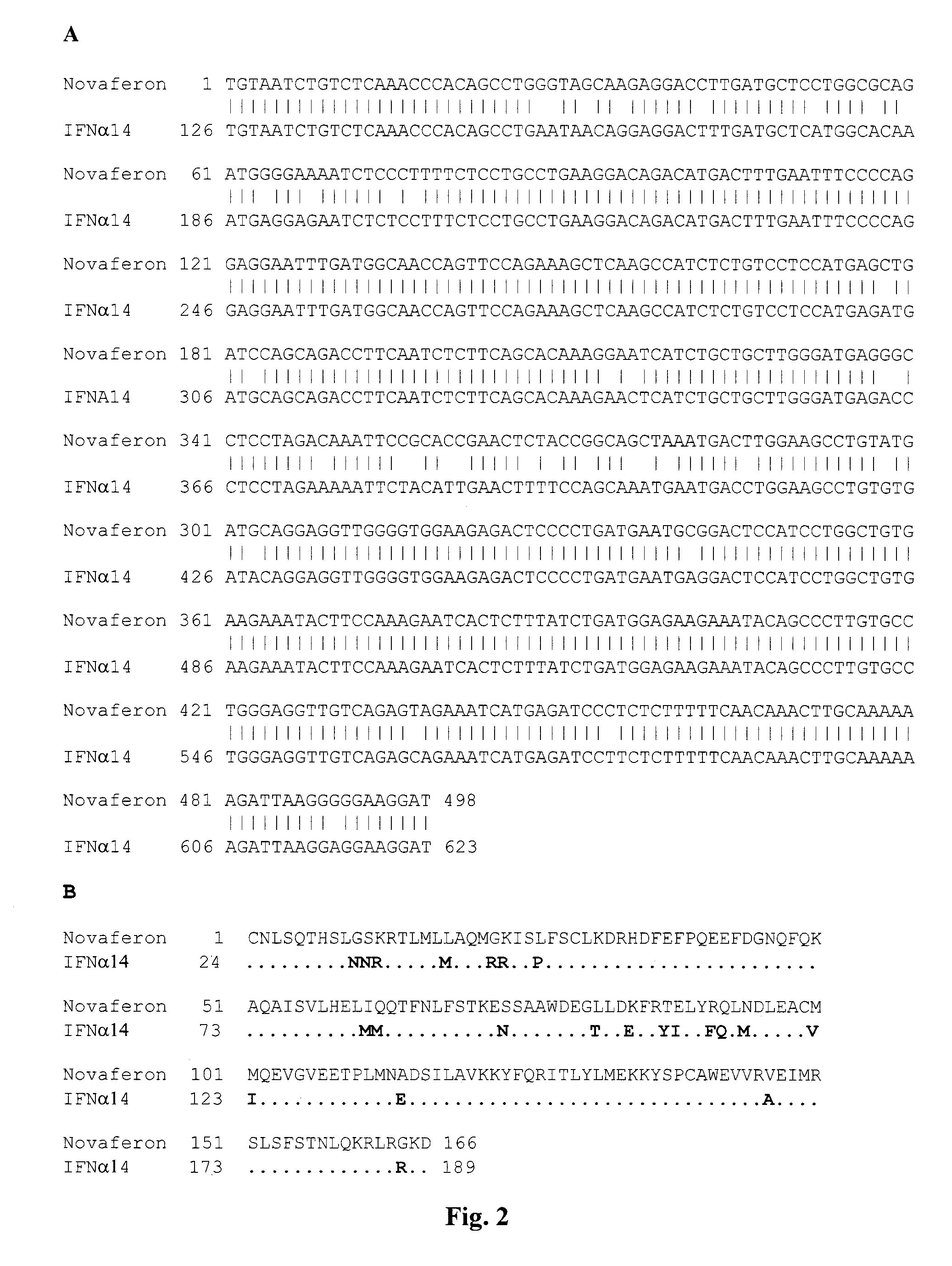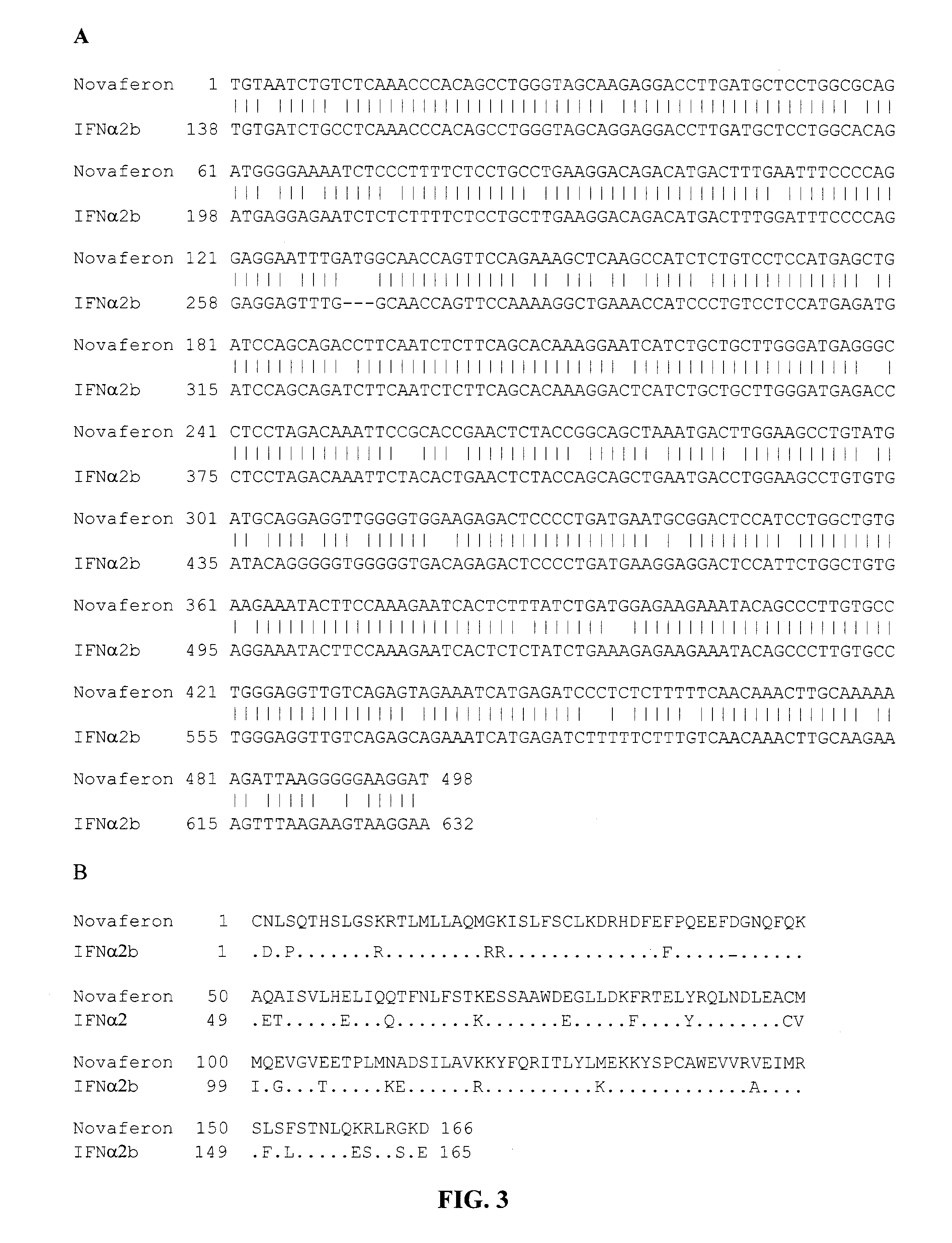Recombinant human interferon-like proteins
a technology of interferon-like proteins and recombinant proteins, which is applied in the direction of peptide/protein ingredients, immunological disorders, drug compositions, etc., can solve the problems of frequent parenteral administration, inconvenient and painful frequent parenteral administration, and high toxic side effects of huifns administration
- Summary
- Abstract
- Description
- Claims
- Application Information
AI Technical Summary
Benefits of technology
Problems solved by technology
Method used
Image
Examples
example 1
PCR Amplification of Human IFN-α Genes from Human Leukocyte cDNAs
[0148]Total mRNA was extracted from human peripheral blood leukocytes. Preparation of cDNA was preformed using Advantage™ RT-for-PCR Kit (Clontech, Mountain View, Calif., US) and a cDNA synthesis primer (oligo dT18) according to the manufacturer's recommendations.
[0149]Amplification of human IFN-α cDNAs was done by PCR technology on a MJ PTC thermal cycler, using the following conditions: 2.5 μl 10×pfx amplification buffer (Invitrogen, Carlsbad, Calif., US), 0.75 μl 10 mM dNTPs, 0.5 μl 25 mM MgSO4, 0.25 μl Platinum pfx DNA Polymerase (2.5 U / μl; Invitrogen, Carlsbad, Calif., US), 0.75 μl cDNA, 0.75 μl 5′ primer (10 μM; IFNaO5: 5′-TGGTGCTCAGCT (A / G)CAAGTC-3′), (SEQ ID No:3) 0.75 μl 3′ primer mixture (1.7 μM each;
IFNaO3-1:(SEQ ID No: 4)5′-AATCATTTCCATGTTG(A / G)ACCAG-3′;IFNaO3-2:(SEQ ID No: 5)5′-AATCATTTCCCGGTTGTACCAG-3′;IFNaO3-3:(SEQ ID No: 6)5′-AATCATTTCCATGTTGAAACAG-3′;IFNaO3-4:(SEQ ID No: 7)5′-AATCATTTCAAGATGAGCCCAG-3′;...
example 2
Construction of Shuffling Libraries of Type I HuIFN-Bearing Plasmids
[0153]To construct plasmids bearing the coding sequence of one of the Type I human IFN-αs, 15 pairs of oligonucleotides, with BamHI and EcoRI restriction sites, were synthesized (Genentech, South San Francisco, Calif., US), based on the individual cDNA coding region for mature human Type I IFN proteins. The GeneBank nucleotide accession numbers for these proteins referenced herein are: NM—024013(IFN-α1), NM—000605 (IFN-α2), NM—010504 (IFN-α4), NM—010505 (IFN-α5), NM—008335 (IFN-α6), NM—008334 (IFN-α7), NM—008336 (IFN-α8), NM—002171 (IFN-α10), NM—002172 (IFN-α14), NM—002173 (IFN-α16), NM—021268 (IFN-α17), NM—002175 (IFN α21). The primers and plasmids constructed in Example 1 as templates were used in a standard PCR (111). The resulting products were cleaved with restriction endonucleases (REs) BamHI and EcoRI and cloned into the E. coli expression vector pBVB, which is a derivate expression plasmid of pBV220 (86) con...
example 3
Screening the Shuffling Libraries
[0157]Freshly transformed E. coli DH5α cells were grown overnight on an LB plate at 37° C. Single colonies were individually picked up and inoculated in 100 μl of LB medium containing 50 μg / ml of ampicillin in 96-well plates. Colonies were shaken at 250 rpm at 30° C. After being cultured overnight, 10 μl of bacterial cultures were duplicately inoculated into 100 μl of LB medium containing 50 μg / ml of ampicillin in 96-well plates. The original plates (so called stock plates) were temporarily stored at 4° C. The cells in duplicated plates were grown at 30° C. until OD600 became 0.4 and were then induced by 42° C. After 4-hour's heat induction, bacteria cultures were directly moved into −80° C. freezer for starting the frozen-thaw cycle. After 2 cycles of frozen-thaw, the bacteria suspension / lysate was diluted to a desired concentration and exposed onto Daudi cell culture for an anti-proliferation test (101) or Wish cell culture for an anti-viral test (...
PUM
 Login to View More
Login to View More Abstract
Description
Claims
Application Information
 Login to View More
Login to View More - R&D
- Intellectual Property
- Life Sciences
- Materials
- Tech Scout
- Unparalleled Data Quality
- Higher Quality Content
- 60% Fewer Hallucinations
Browse by: Latest US Patents, China's latest patents, Technical Efficacy Thesaurus, Application Domain, Technology Topic, Popular Technical Reports.
© 2025 PatSnap. All rights reserved.Legal|Privacy policy|Modern Slavery Act Transparency Statement|Sitemap|About US| Contact US: help@patsnap.com



